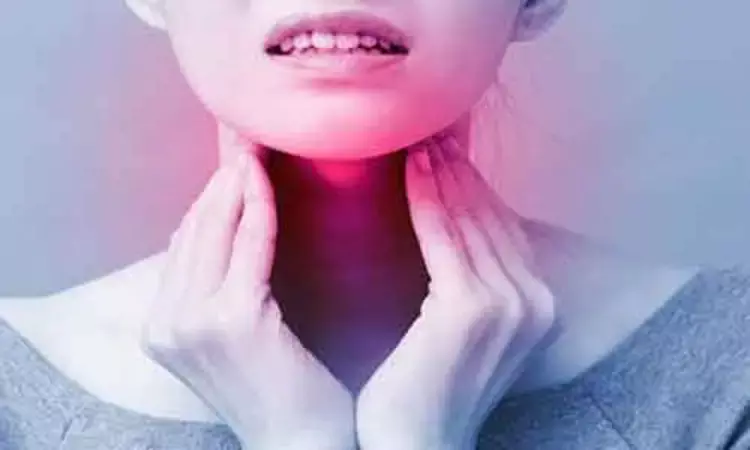- Home
- Medical news & Guidelines
- Anesthesiology
- Cardiology and CTVS
- Critical Care
- Dentistry
- Dermatology
- Diabetes and Endocrinology
- ENT
- Gastroenterology
- Medicine
- Nephrology
- Neurology
- Obstretics-Gynaecology
- Oncology
- Ophthalmology
- Orthopaedics
- Pediatrics-Neonatology
- Psychiatry
- Pulmonology
- Radiology
- Surgery
- Urology
- Laboratory Medicine
- Diet
- Nursing
- Paramedical
- Physiotherapy
- Health news
- Fact Check
- Bone Health Fact Check
- Brain Health Fact Check
- Cancer Related Fact Check
- Child Care Fact Check
- Dental and oral health fact check
- Diabetes and metabolic health fact check
- Diet and Nutrition Fact Check
- Eye and ENT Care Fact Check
- Fitness fact check
- Gut health fact check
- Heart health fact check
- Kidney health fact check
- Medical education fact check
- Men's health fact check
- Respiratory fact check
- Skin and hair care fact check
- Vaccine and Immunization fact check
- Women's health fact check
- AYUSH
- State News
- Andaman and Nicobar Islands
- Andhra Pradesh
- Arunachal Pradesh
- Assam
- Bihar
- Chandigarh
- Chattisgarh
- Dadra and Nagar Haveli
- Daman and Diu
- Delhi
- Goa
- Gujarat
- Haryana
- Himachal Pradesh
- Jammu & Kashmir
- Jharkhand
- Karnataka
- Kerala
- Ladakh
- Lakshadweep
- Madhya Pradesh
- Maharashtra
- Manipur
- Meghalaya
- Mizoram
- Nagaland
- Odisha
- Puducherry
- Punjab
- Rajasthan
- Sikkim
- Tamil Nadu
- Telangana
- Tripura
- Uttar Pradesh
- Uttrakhand
- West Bengal
- Medical Education
- Industry
Exposure to nighttime artificial lights linked to elevated thyroid cancer risk: Study

People living in regions with high levels of outdoor artificial light at night may face a higher risk of developing thyroid cancer. The finding comes from a study published early online in CANCER, a peer-reviewed journal of the American Cancer Society.
Over the past century, nightscapes--especially in cities--have drastically changed due to the rapid growth of electric lighting. Also, epidemiological studies have reported an association between higher satellite-measured levels of nighttime light and elevated breast cancer risk. Because some breast cancers may share a common hormone-dependent basis with thyroid cancer, a team led by Qian Xiao, PhD, of The University of Texas Health Science Center at Houston School of Public Health, looked for an association between light at night and later development of thyroid cancer among participants in the NIH-AARP Diet and Health Study, which recruited American adults aged 50 to 71 years in 1995-1996. The investigators analyzed satellite imagery data to estimate levels of light at night at participants' residential addresses, and they examined state cancer registry databases to identify thyroid cancer diagnoses through 2011.
Among 464,371 participants who were followed for an average of 12.8 years, 856 cases of thyroid cancer were diagnosed (384 in men and 472 in women). When compared with the lowest quintile of light at night, the highest quintile was associated with a 55 percent higher risk of developing thyroid cancer. The association was primarily driven by the most common form of thyroid cancer, called papillary thyroid cancer, and it was stronger in women than in men. In women, the association was stronger for localized cancer with no sign of spread to other parts of the body, while in men the association was stronger for more advanced stages of cancer. The association appeared to be similar for different tumor sizes and across participants with different sociodemographic characteristics and body mass index.
The researchers noted that additional epidemiologic studies are needed to confirm their findings. If confirmed, it will be important to understand the mechanisms underlying the relationship between light at night and thyroid cancer. The scientists noted that light at night suppresses melatonin, a modulator of estrogen activity that may have important anti-tumor effects. Also, light at night may lead to disruption of the body's internal clock (or circadian rhythms), which is a risk factor for various types of cancer.
"As an observational study, our study is not designed to establish causality. Therefore, we don't know if higher levels of outdoor light at night lead to an elevated risk for thyroid cancer; however, given the well-established evidence supporting a role of light exposure at night and circadian disruption, we hope our study will motivate researchers to further examine the relationship between light at night and cancer, and other diseases," said Dr. Xiao. "Recently, there have been efforts in some cities to reduce light pollution, and we believe future studies should evaluate if and to what degree such efforts impact human health.
https://acsjournals.onlinelibrary.wiley.com/doi/10.1002/cncr.33392
Hina Zahid Joined Medical Dialogue in 2017 with a passion to work as a Reporter. She coordinates with various national and international journals and association and covers all the stories related to Medical guidelines, Medical Journals, rare medical surgeries as well as all the updates in the medical field. Email: editorial@medicaldialogues.in. Contact no. 011-43720751
Dr Kamal Kant Kohli-MBBS, DTCD- a chest specialist with more than 30 years of practice and a flair for writing clinical articles, Dr Kamal Kant Kohli joined Medical Dialogues as a Chief Editor of Medical News. Besides writing articles, as an editor, he proofreads and verifies all the medical content published on Medical Dialogues including those coming from journals, studies,medical conferences,guidelines etc. Email: drkohli@medicaldialogues.in. Contact no. 011-43720751


